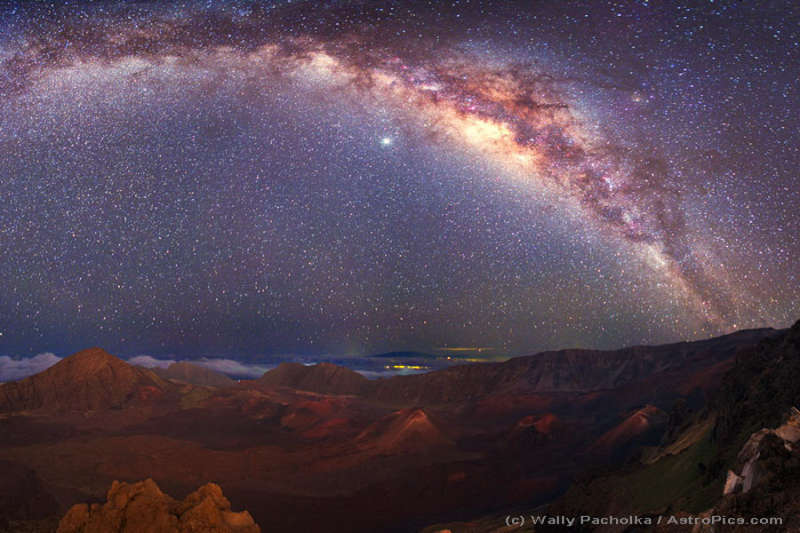
|
Credit & Copyright: Wally Pacholka
(TWAN)
Explanation:
Have you ever seen the band of our Milky Way Galaxy?
In a clear sky from a dark location at the right time, a faint band of light becomes
visible across the sky.
Soon after your eyes become
dark adapted,
you might spot the band for the first time.
It may then become obvious.
Then spectacular.
One reason for a growing astonishment might be the realization that this
fuzzy swath
contains billions of stars and is the disk of our
very own
spiral galaxy.
Since we are inside this disk, the
band appears to encircle the Earth.
Visible in the above image, high above in the night sky, the
band of the Milky Way Galaxy arcs.
The bright spot just below the band is the planet Jupiter.
In the foreground lies the moonlit caldera of the volcano
Haleakala,
located on the island of
Maui in
Hawaii,
USA.
A close look near the horizon will reveal light clouds and the dark but enormous
Mauna Kea volcano on the
Big Island of Hawaii.
If you have never seen the Milky Way band or recognized the
planet Jupiter, this year may be your chance.
Because 2009 is the
International Year of Astronomy,
an opportunity to look through a
window that peers deep into the universe
may be coming to a location near you.
|
January February March April May June July August September October November December |
| ||||||||||||||||||||||||||||||||||||||||||||||||
NASA Web Site Statements, Warnings, and Disclaimers
NASA Official: Jay Norris. Specific rights apply.
A service of: LHEA at NASA / GSFC
& Michigan Tech. U.
Based on Astronomy Picture
Of the Day
Publications with keywords: Milky Way
Publications with words: Milky Way
See also:
- APOD: 2025 July 2 Á Milky Way Through Otago Spires
- APOD: 2025 May 20 Á Milky Way over Maunakea
- APOD: 2025 May 13 Á Gaia Reconstructs a Top View of our Galaxy
- APOD: 2025 May 12 Á Gaia Reconstructs a Side View of our Galaxy
- Galaxies in Space
- APOD: 2025 February 9 Á Milky Way over the Australian Pinnacles
- APOD: 2024 November 24 Á Journey to the Center of the Galaxy
